First a longer SVT reportage one year after the grounding – worth watching.
https://www.youtube-nocookie.com/embed/LE9hl6WIP4o?rel=0&autoplay=0&showinfo=0&enablejsapi=0
SVT’s 2024 production “Whiskey on the Rocks” seems to have forgotten the above reportage and was not well received by those involved – they felt that the production played down the violation and promoted alternative theories.
The Armed Forces were somewhat ridiculed even though it was masked in comedy and they pursued the drunken sailor angle, which may be a bit more serious, after all, it is stated on the website that it is based on reality.
Then, a M. Fredholm has released a book this year that is supposed to put an end to all speculations – U137 did actually navigate incorrectly.
He is an FRA veteran and without having read the book since I am poor and cannot afford it, I understand from the link below that he bases his assumption on the fact that the first Soviet search effort was made where U137 had been the day before – around Bornholm.
https://www.goodreads.com/book/show/239770748.U_137_inifr_n_
Now that Russia has shown that they are similar wreck looters roaming around like a locust swarm in our geographical vicinity, I am considering whether we should start reconnecting to our country’s other major open wound after the Palme assassination (which is now healed) – the submarine intrusions in the 80s.
At least SVT and Fredholm found it interesting enough to make a TV show and write a book about.
What could be better than showing that it wasn’t misnavigation that caused U137 to run aground just to annoy SVT so they have to remove “based on reality” from the description of their program above?
So what really happened on that fateful night that ended with a Soviet submarine running aground in our inner archipelago in the middle of a military restricted area and revving up the engines?
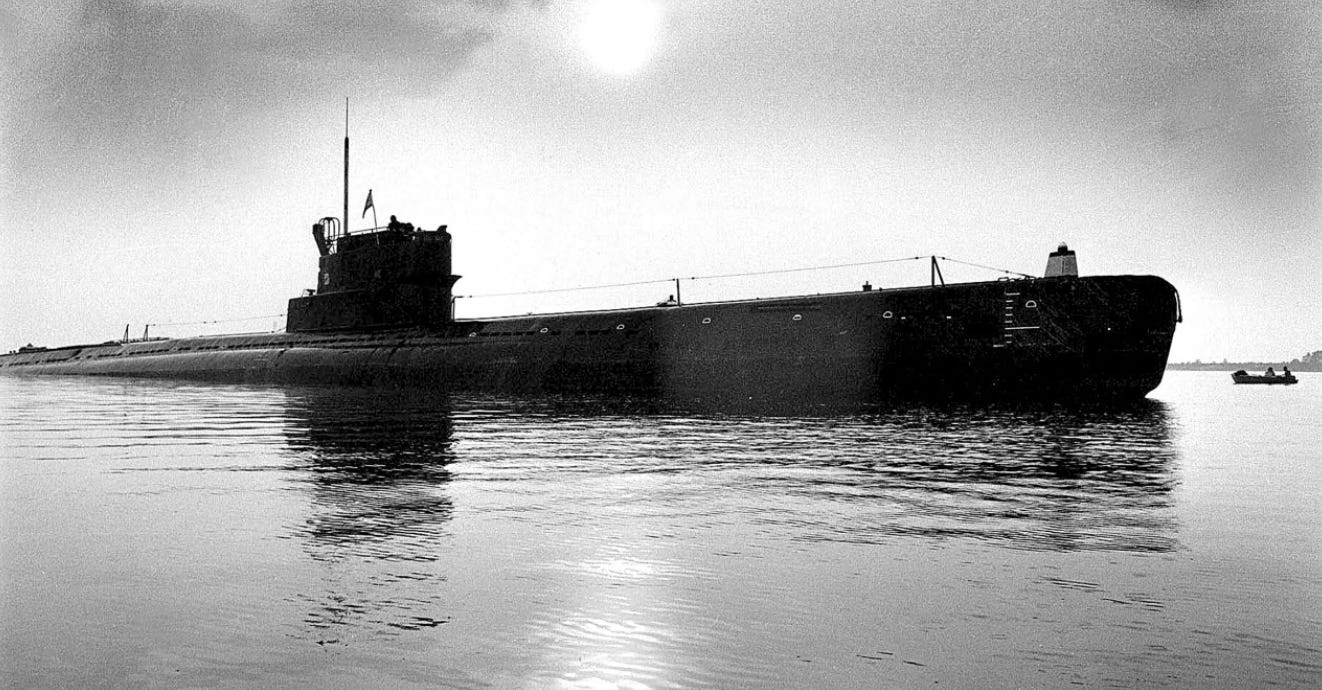
The Soviet submarine U137 (S363) ran aground on a blind rock on October 27, 1981 at 19:57 right at the entrance to Gåsefjärden.
“Hold the line,” thundered Torbjörn Fälldin statesmanlike when he was eventually informed.
A dozen hectic days followed, ending with U137 being assisted in getting free, escorted to the territorial water border, and from there the situation de-escalated.
If one wants to be picky, the only thing we did was to return U137 to the Soviet Union, so we may not have appeared as Viking-like as Fälldin thundered – even though the Armed Forces were fully prepared to engage with what they had if needed.
16 coastal rangers stood for a few days trying to figure out how to take over the submarine, and their feedback to the command center was – forget it.
Overall, the government and the Armed Forces acted very elegantly, although, just like now, we had managed to systematically disarm since the 70s and hit upon capabilities that would have been troublesome for the Soviet Union.
An absolutely sensational world news because it was now indisputable that the Soviet Union was cruising far inside our inner archipelago with a large conventional submarine and in the middle of a military restricted area,
The highly humiliating grounding occurred shortly after the end of exercise Zapad 81, which was a very large Soviet exercise in the Baltic Sea at the time, in which U137 participated.
Facts in the case;
- U137 was moving in the area northeast of Bornholm before heading towards Sweden1.
- A group from Oznaz2 was on board U137 along with an officer who was the chief of staff for the 157th submarine brigade based in Paldiski, a commander Avrukevitj.
- U137 crossed the Swedish territorial water border about 30 minutes after nightfall, which was around six o’clock (sunrise the next day was around 07:00).
- The military became aware of the violation at ten o’clock the day after.
- The submarine was in an intermediate position and traveling at 8 knots at the time of the grounding at Torumskär3.
1. image below and is based on the submarine’s navigation log.
2. a Swedish translation of the Soviet investigation into the accident that Sweden had access to, posted on May 19, 2016 in the Sillar and Minkar thread on Skalman.
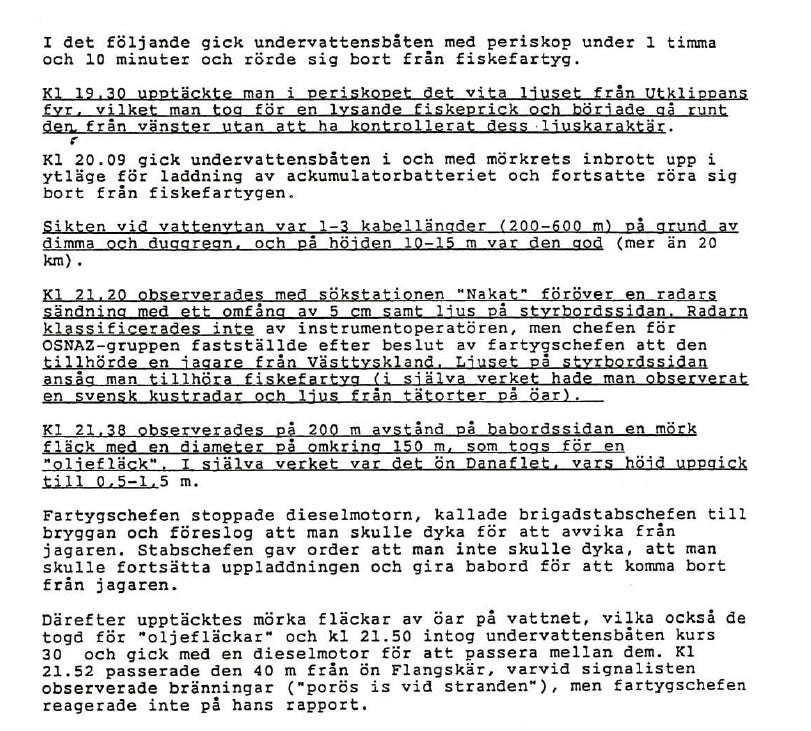
3. it now says Torhamnaskär on the maps, but Torumskär is the common name for the grounding location.
Nothing is guesswork as it is based on technical evidence, such as the navigation log and the Soviet’s own report on the major accident.
Information that may be useful to know;
A Whiskey in surface position requires a 4.55m freeboard according to available specifications.
Just west of Torumskär, the water depth is 14m, then shallows to 12m further in, and finally 6.7m at the innermost point.
The area is sparsely populated compared to other bays and fjords in the vicinity.
At this time, the area had war mooring places, which means that the water depth was probably greater than indicated on civilian maps – this is a qualified assumption from me, and for safety’s sake, we stick to the civilian map.
If one were to want to navigate a submarine into the area around the Karlskrona naval base, Gåsefjärden is a very well-chosen place in peacetime – you can look around on this nautical chart and switch to Google Maps if you’re bored at work. Not much settlement, no civilian fairway, no course change required to enter directly, and the water depth is acceptable.
The definition of an intermediate position that U137 was traveling in – so it’s not fully surfaced, but a part of the submarine is visible above the surface. It should be noted that the draft will be deeper than in the surfaced position.

Protected objects in the vicinity of the grounding location;
We know that there was an FRA station on Utlängan, and according to a participant in the Skalman thread, the cable ran from the station up to the FRA facility in Lösen.
Gåsefjärden is located right in between the shortest distance.
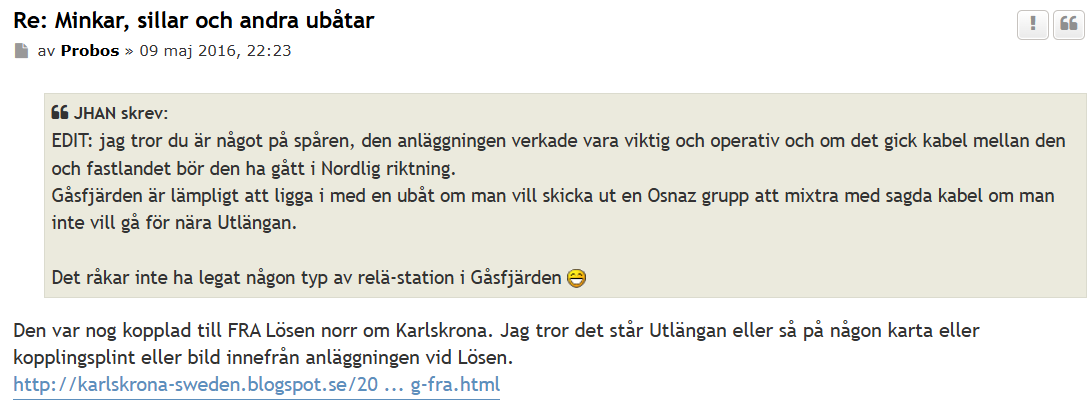
https://karlskrona-sweden.blogspot.com/2008/12/det-var-en-gng-fra.html
The Karlskrona naval base was of course also in the broader geographical area.
Gåsefjärden was a war mooring place for the navy with a mine barrier and a guard post (since the battery at Tjurkö was unmanned, I guess the guard post was also unmanned).
I am very fond of this type of sources.
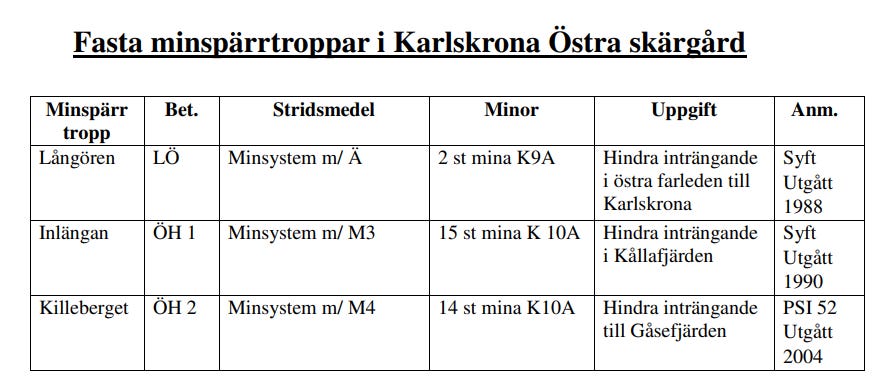
https://ka2samverkan.se/wp-content/uploads/2023/10/forsvaretoblekinge.pdf
There were several military targets in the vicinity – and in terms of what lawyers talk about, we have identified a possible intent since U137 was military.
Since U137 had operators from a special forces unit on board along with the chief of staff of the entire submarine brigade, it is not unreasonable to assume that the submarine had a mission beyond the ordinary.
If U137 had crashed into Utklippan lighthouse in surfaced position at full speed, I wouldn’t have written this series of posts.
So what did U137 do on that fateful night
The ship’s captain immediately claimed that the submarine had navigated incorrectly and found itself off the coast of Poland, east of Bornholm. This is to be supported by the fact that the first Soviet rescue efforts went to the area where U137 had been the day before.
This also seems to be what M. Fredholm’s book bases its assumptions on, but the Soviets initially contradicted themselves, so
The captain stated that he believed he was at Christiansö – the initial search effort was further east than that and as soon as the sun rose after sometime past seven o’clock, U137 must have realized that they were in someone’s inner archipelago and communicated it. The fact that aircraft were circling over a different geographical area several hours later is a poor argument to base an entire book on; below is a good summary of that track and why it is incorrect.
https://kkrva.se/u-137-intrang-ska-framsta-som-oavsiktligt/’
Before U137 began its journey towards Gåsefjärden, it traveled in silent mode in a “circular pattern” in said area. It is either a standard patrol pattern or similar to what planes do when waiting to land – I haven’t found any information on which one it is, although it is highly significant.
As the submarine approached the cliff’s lighthouse, it went into periscope depth and then into intermediate depth, making several course changes towards the cliff’s lighthouse.
The probability that they didn’t know what they were doing is probably nonexistent.
“The final course change before entering Gåsefjärden occurred at a point that can be determined precisely by the fact that the lighthouses Flöjten and Flundrebådan are aligned, while the light from the Utlängan lighthouse transitions from red to green sector.”
https://sv.wikipedia.org/wiki/U_137
The image below comes from the investigation SOU1995 and is based on U137’s own navigation log. The Defense Forces did a great job here; they received the log indicating that they were somewhere near Bornholm, but they started from the grounding site and worked backward – they reconstructed U137’s actual route because times and course changes were documented.
The Soviets probably didn’t anticipate that.
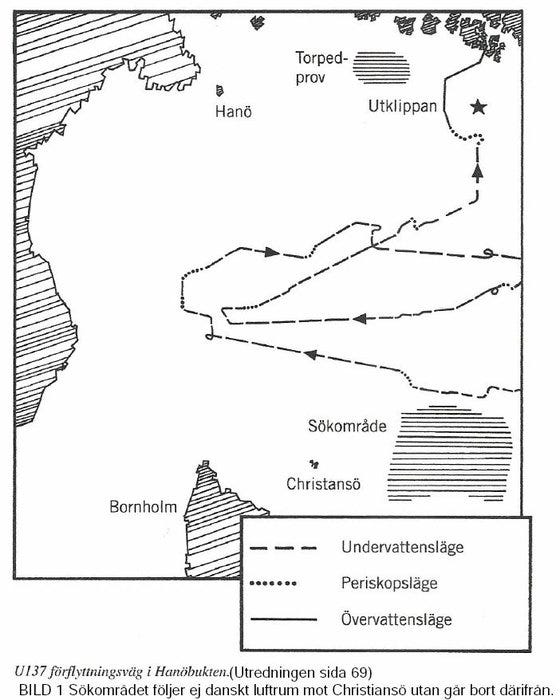
One initial observation is that during the day, the submarine operated in silent mode and then briefly surfaced to periscope depth.
As they approached Sweden after nightfall, the pattern changed, and they went to intermediate depth before grounding.
An altered operational pattern to begin with.
There are various speculations about why they went to intermediate depth, one being that they wanted to resemble a boat as much as possible in the dark – not too high and not underwater in silent mode. If they had been detected on radar, it might have been easy to dismiss them as a fishing boat perhaps; the navy suggests this as an explanation for why they didn’t detect U137 on the way in – but they also had some pressure to try to explain how they managed to miss everything.
Again – if U137 had continued to circle in silent mode in ever-widening circles and crashed into the Utklippan lighthouse, you wouldn’t be reading anything from me.
The Utklippan lighthouse, towards which U137 made course changes, is a 30m high structure that also stands on a height above the water surface – and moreover, it is within the area where U137 normally navigated.
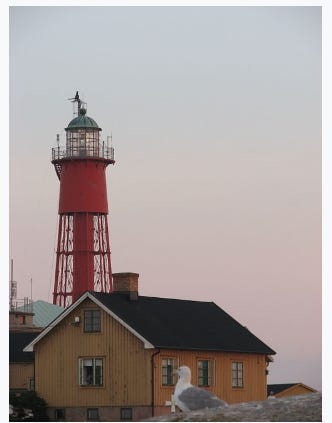
https://en.wikipedia.org/wiki/Utklippan
So what was the actual accident – did U137 drive straight onto land like amateurs, as we have all seen in the pictures of a submarine stranded on a rock with a tearful captain in the tower casting longing looks at the photographer and truly hating his life?
No, Torumskär is a shallow blind skerry, and there is a military fairway immediately west of the grounding site, and U137 made course changes precisely after the Utklippan lighthouse to enter the area directly.
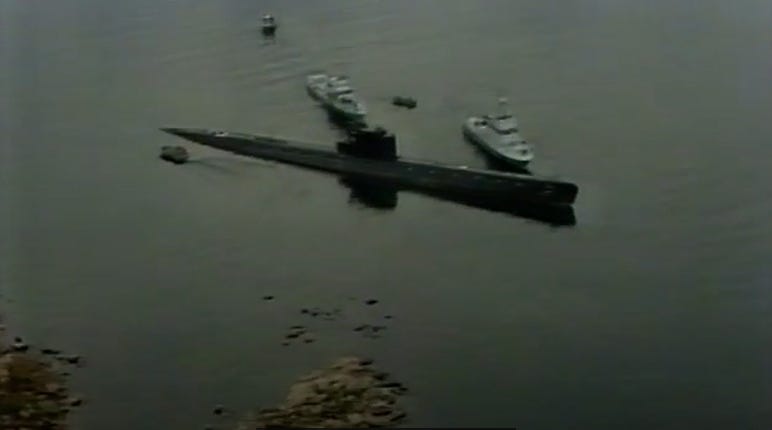
U137 ran aground, and the energy propelled them a bit further, but it was a very small navigation error that led to the grounding – seconds and meters.
In fact, there are landmarks that the navy navigated by, and a week before the grounding, an officer sailing in the area observed that a landmark had collapsed, almost causing him to run aground on Torumskär himself.
We know that there were landmarks and a military fairway; whether a landmark collapsed depends on whether we consider the source reliable or not.

We also don’t know if the Soviets navigated by them, but the landmarks were there in the area to navigate by if desired.
This brings us to the end of this post; the next post will focus on those who have become prominent in the debate, followed by weighing arguments against each other so that you can draw your own conclusion on whether U137 was an intentional violation or not.
Because that’s the important part – was U137 on a real mission or not.
Who claimed that everything was due to unfortunate circumstances – the Soviets.
Does Putin ever claim once a month that Russia never intended to attack Ukraine, that it’s all NATO’s fault, that he doesn’t want to conquer all of Ukraine, and so on?
On Substack – there is still a chance to become subscribers, and it would be valuable to me if you want to become paying ones. All content is posted freely to everyone, but it still takes a lot of time to put together; it costs 80 SEK per month, and then you skip a meal at McDonald’s, so it’s also healthy – Johan No.1 makes you healthier too 👍
Continued appreciation for the site johanno1.se is always gratefully received, and there is a QR code for the purpose that you absolutely must not miss, as we have costs and there is a donation page with links to Swedish Rescuers, drones 2 Ukraine, and other organizations we have learned over time are legitimate and dare to donate to.
If you liked the post – please share it in your channels, and most importantly, feel free to share the English version with people you think may appreciate posts and comments they haven’t been able to read before.
https://bsky.app/profile/johanno1.bsky.social
Don't forget to donate, Ukraine's cause is ours! Support Ukraine!

Interesting reading!
I can only agree.👍👍👍
Can only agree 👍
Fan 😶
I am familiar with the demolished lighthouse through a friend who was in the naval reserve.
Nice picture of Utklippan. We used to sail there once a year and stay overnight. Utklippan has a nice little harbor accessible even for foreign boats. The caretaker (not a lighthouse keeper – the lighthouse is unmanned) sold smoked eel. This was before the eel was red-listed, it’s worth adding. Hardly any sailing without a submarine hunting helicopter in the air. Last times it was a Super Puma.
It seems like you have been a bit everywhere 😀
I will try to write about the other violations too if you know more 👍
Just that. If you had asked me if I had been to Midway during the Cold War, I would have answered yes. October 1970.
a living Carl Hamilton
At 17 years old and mostly just getting in the way. The salt-sprayed sailors took care of the problem. But we received a lot of praise from the Yankees. And yes; a B 52 was ready for takeoff. No sea chart for the port, no pilot, and 6,000 tons of citrus on the boat. Only a military tugboat leading the way. A rescue operation that ended happily.
There is an aspect here that I think is being forgotten.
We KNOW that the Soviet Union could take great risks AND sacrifices, in order to achieve important goals.
Could it be that the “grounding” was actually intentional, to divert attention away from something more important? Because, EVERYONE’s eyes were now on U137.
So the question is, what happened that we didn’t see, somewhere else??
Chat GPT says the following:
we still don’t know how many Soviet submarines were actually in the Baltic Sea during those days. Many testimonies and sonar observations afterwards suggest that something more was moving out there.
Yes – the navy was chasing another submarine out by the lighthouse at Utklippan the morning after they lost track of it.
That’s a fact.
—
There are rumors that a mini-submarine was in the area during the torpedo tests (the torpedo tests are a fact) and as soon as U137 communicated back to base, it received orders to abort and was loaded onto a ship with a bottom hatch, a MUNA boat (they existed, that’s a fact).
—
It has been speculated that the Soviet Union used 2-3 submarines where one would expose itself to draw the submarine hunt while the others carried out their missions.
Well, I don’t think U137 was the one to expose itself there, they probably ran aground by mistake 😀
Karl Andersson said during his first interrogation on board the submarine that he first saw a detailed nautical chart that was only used by the Swedish navy, but when Gushtjin or the political officer Besedin discovered this, they immediately returned with another nautical chart. The interview is available online but I can’t find it right now. That says it all about the crew knowing what they were doing.
So it was 👍
Bra med massa positiv feedback här – ska fortsätta med ytterligare inlägg kring ubåtskränkningarna.
I look forward to that.👍
Good 😀
Interesting reading
I look forward to part 2
✊✊
Väldigt intressant!